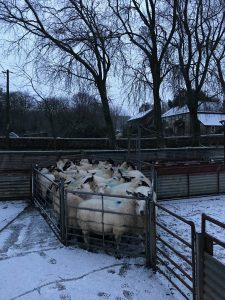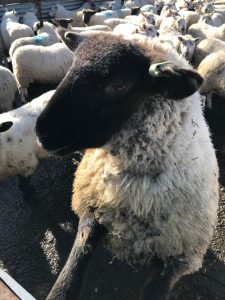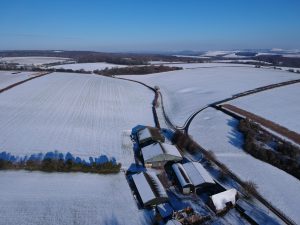View from the Hill 12th February 2019
It was pretty while it lasted, the dreaded white stuff, and didn’t cause much trouble on the farm, but that will do for this year thanks. It gave people a chance to get the toboggans out and enjoy some family fun on the slopes behind the village. As you can see from this picture, the lambs (well hoggets now it’s past Jan 1st) were quite relaxed about it, sitting in the sunshine. Their fleeces keep them so well insulated they really don’t notice the weather, except when it is raining horizontally. The turnip leaves weren’t buried, and the turnips themselves hadn’t frozen solid, so there was plenty to eat.
We have just had our first draw of lambs for the dinner table trade, and sent on 42 direct to the abattoir, a further 30 were a bit too tubby for the discerning buyer, so they were sent to Frome market, where the buyers aren’t so fussy. We also had a few old ewes to send on who can no longer be bred from. I would put in a word here for the provenance of this healthy meat, it has been reared largely on grass, from land which is steep or otherwise not suitable for growing other crops, which therefore cannot be used to feed humans, unless converted first into animal products. Combining the low input nature of our stock farming, and the stewardship scheme we belong to, this meat is all but organic, just not registered as such. The turnips are not organic, so we could not register our sheep as organic even if we tried, under our current system.
To add another potentially controversial comment to the mix, we are striving to make sure all our lambs have left the farm before 29th March, because if the UK leaves the EU without an agreement for the transition period, we will overnight become subject to WTO (world trade organisation) trade rules and EU tariffs, meaning that anyone across the channel who wants to buy our British sheep meat, will have to pay an extra 51% for it to be allowed into the EU. Much of the of lamb grown on farms in the south of England is currently exported to France.
Likewise our spring malting barley, which is highly sought after by many European brewers, will overnight be subject to a tariff of 53%. It is not difficult to imagine what an effect this would directly have on our income, hence we are doing our utmost to make sure all of last year’s barley has left the farm well before B-day, as well as the lamb. How long will we have to wait before the muppets running the country can sort things out? We have had to decide already what crops to plant this spring, and whether to put our ewes in lamb, having no idea what market there will be to sell them into in a year’s time.
I might also add that WTO rules could affect us in far more sinister ways. As I understand it, in the event of a no-deal, the UK will have to decide very quickly if it is going to impose tariffs on goods entering the country. The UK has a history (before joining the EEC) of being a low, or no tariff trader, and if this turns out to be the case after 29th March, we will suddenly be vulnerable to tariff-free imports of food products from all over the world, many of which will have been produced to very different standards to those which are allowed in the EU. Crop protection chemicals that were banned in the EU long ago, GM based foods, hormone treated meat and milk products, are still used and produced very widely in the rest of the world, and unless our government decides it will vigorously continue to exclude these products, farming as we know it in the UK will not last very long. Some might call this Project Fear, however I see it as the reality of what could happen if we leave the EU in a disorderly fashion, and this is just the farming industry.
The UK is only 60% self sufficient in food, which means we need to import a great deal of food, all that which cannot be grown in the UK, and a good deal which can be but not all year round.

Tangle, one of last year’s orphans, named after beers, still likes toast
A farmer from Suffolk, well known for his success in organic crop growing, came to speak to a group of interested farmers at The Langton Arms last week, the room was packed, and there were a great many questions from the floor. The speaker, John Pawsey, fielded all with good humour and his talk was very interesting. His system is unusual, in that when he started converting in 2000, he was determined to show that organic cropping was feasible without animals in the mix. In order to grow organic crops successfully, you need at least 2 years of a 5 or 6 year rotation growing a fallow or fertility-building crop. The doubters amongst us cannot believe that you can grow an organic crop rotation without livestock to help build up fertility, either as grazing animals, or by adding large quantities of their manure. John still grows crops without animals on land that he contract farms, but on his own farm he has weakened, and added sheep to the mix, which graze the 2 year clover leys, which he finds is the best way to build fertility. He is trying to convert his contract customers to sheep as well.
I do wonder if it is possible, acceptable or sustainable, to be both vegetarian (or vegan) and organic.
One of Mr Pawsey’s techniques is to use a clever machine which doubles as a drill and a hoe, which when controlled by high resolution satnav, is a very impressive tool for weeding between the rows of growing crops. (Being organic, he obviously can’t use weedkiller!)
 This picture shows the business end of the machine in hoeing format, the tip is tungsten, very hard wearing, and the wing digs out weeds without disturbing too much soil. This coulter is one of many across the 9m wide machine.. The wheel you can see behind the coulter controls coulter depth, and firms the soil again.
This picture shows the business end of the machine in hoeing format, the tip is tungsten, very hard wearing, and the wing digs out weeds without disturbing too much soil. This coulter is one of many across the 9m wide machine.. The wheel you can see behind the coulter controls coulter depth, and firms the soil again.
An on-farm meeting near Milborne in the last week of January saw a large number of farmers gather in a field to look at a cover crop trial which compares 16 different species and seed mixtures in 128 different combinations. It is an ingenious idea, laid out like a chess board, with much credit to the host farmer, John Martin, for the success of it, he assured us that it was surprisingly simple to put into action. It was fascinating to compare different mixtures, some were clearly not suited to each other, but many had worked well. Tests have been done to see which mixtures favour insect life the most, and others are investigating the amount of nitrogen and other nutrients that has been fixed by the crop, preventing it from washing down through the soil, and saving it in plant form for use by the following commercial crop. There will be a huge amount of useful information generated by this trial, and farmers will use its results to help them decide which cover crops to plant for next winter. On our farm this season, we have grown phacelia, buckwheat, berseem clover and linseed. (See picture above from last autumn). We plan to tweak it a bit for next season, but are going to steer clear of grasses and brassicas. The aims include strong rooting, speedy establishment, favouring of soil organisms, good soak up of spare nutrients, and provision of food and habitat for birds and insects in the late autumn and winter. Below is the seeds mixture in the trial which most closely matches our own.
To brighten this month’s broadcast, here are some more snowy pictures. Click picture to enlarge.
Looking north east towards Websley, and across the Stour valley, with Stourpaine in the left middle distance.
Looking west over Shepherds Corner to the left, with Hambledon Hill in the right hand distance.
Looking east towards Blandford. Long shadows from Blackfern wood.
 The thaw begins on the workshop roof, dripping into the gutter.
The thaw begins on the workshop roof, dripping into the gutter.
 This mole is having a laugh, he has filled up the bucket covering the trap, with soil from below, then it froze!
This mole is having a laugh, he has filled up the bucket covering the trap, with soil from below, then it froze!
And one of this year’s first calves – more next time.








Most interesting as always. Would I be correct in thinking that you want to avoid brassica and grass in field margins and leys because they over winter pests and diseases that afflict your main crops?
Why are you trapping moles in what looks like pasture?
Very good .I see the drone is coming in to it’s own
Well Hidi there Georgie, looks like a sweet little bit of a farm you got yourself there. I am thinking you need to get rid of some of those hedges, widen the fields and flatten some of those hills. You come over Stateside sometime and I can arrange for some of Donald’s friends and supporters to show you how real farming is done; none of this European museum nonsense you are playing about with. Ambassador and Out.